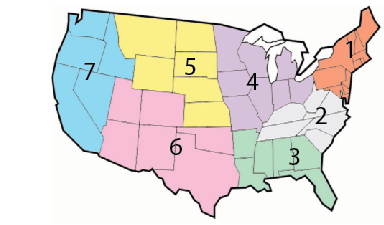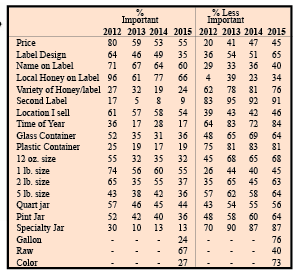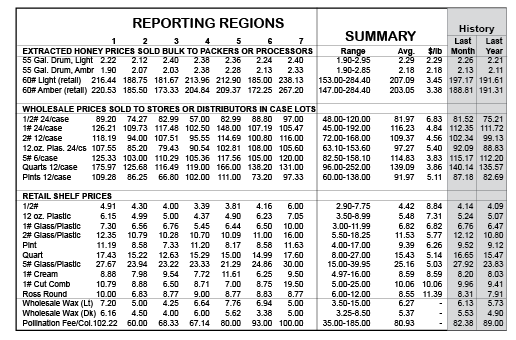by Bee Culture Staff
Honey. Everyday Recipes For Cooking And Baking with Nature’s Sweetest Secret Ingredient. By Angelo Prosperi-Porta. Published by Greystone Books Ltd, Surrey, BC. ISBN 978-1-77151-108-7, 8” x 9”, 180 pgs, color throughout, soft cover, $22.95 U.S.
I know a little bit about cooking with honey. I put a bunch of mostly tried-at-home recipes in each of my books but I’m not creative enough to make them up. I scoured lots and lots of cooking with honey books, some very, very old, others more contemporary, to find those that I could alter to just my liking and went from there. And I used several of them when a Japanese film crew came to my house last spring to film me cooking BBQ wings, salad and a dessert all made with honey out on the deck.
And I’ve reviewed a lot of cooking with honey books on these pages over the years. Some have been well done, most were makeovers, much like what I did, that were useful, but bordered on boring. Only a very, very few stand out on my recipe shelf. Honey is such a fantastic ingredient in almost anything you want to make that it’s a shame to under use it when cooking.
Let me tell you, this Italian Chef, living in British Columbia and teaching at a cooking school, does not ever under use honey. And I don’t think I’ve ever seen a single recipe in any other book that he offers here.
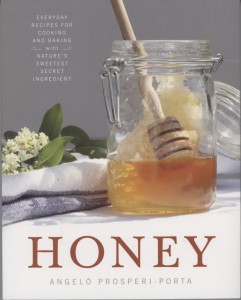
He does the mostly traditional format – breakfasts, breads, side dishes, main dishes, desserts, sauces and beverages. But, oh, are they all so different than what you have tried in the past. For breakfast I choose warm chocolate almond crepes with raspberry honey butter, and for later, the rosemary, honey and cornmeal scones made me hungry just reading the ingredients. An excellent side dish was the honey and balsamic-glazed shallots, and for the main course I’ll go with the honey and lavender-brined chicken breast.
Did I mention the brines? Simply, they are water, salt and honey…and then herbs and spices to taste and enjoy. I’d watch the cooking channel 24/7 if I could, and almost every chef uses some kind of brine, but none use just honey and salt and spices.
This chef’s Italian background really comes into play with desserts, with almost all of them with an Italian flair. I haven’t had time to explore these in the kitchen yet, but the rhubarb, honey and fresh thyme sorbettor, or the honey almond brioche both read well.
If you don’t own a honey cookbook, I’d recommend this one for starters. If you do, graduate to this one. And don’t blame me when you read the scale. Kim Flottum
Simple, Smart Beekeeping. By Kirsten S. Traynor and Michael J. Traynor. ISBN 978-0-9723492-2-2. Image Design Publishing. 8” x 10”, 180 pgs, soft cover, color throughout. $34.95 at Amazon or www.simplesmartbeekeeping.com.
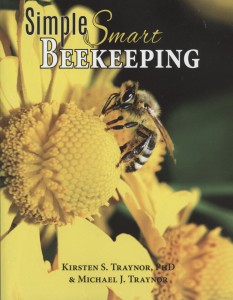
Kirsten and Michael have spent months traveling Europe learning beekeeping techniques, and Kirsten has a Ph.D in honey bees and is now working for the BIP program, so she has access to lots of good information that’s current. And Michael has spent time photographing various parts of the world for National Geographic and lots of time with bees. This makes a pretty good combination to put together a fine beginner beekeeper’s book.
Chapters include history, one on a beekeeper’s alphabet (a list of words used by beekeepers, but repeated in the appendix), bee biology, getting, putting and installing bees, hive health, Varroa management, other pests, supering, records, Summer work, wintering up to getting ready for spring. There are a lot of topics covered in this book. The depth of the information on each is limited, but you don’t want to overwhelm beginning beekeepers. The ‘bee aware of this’ method is good and doesn’t usually frustrate a beginner.
The photography needs mention. In far, far too many beginner books the publishers want stunning, up close photos that show stunning up close bees. Little or nothing about how to, when to, it looks like this. That’s not the case here. The photos are stunning, up close photos showing exactly what needs to be seen describing a given task or subject. I was impressed (however, we published one of those photos on a cover a while back, so I expected no less) with every page.
Another good beginner’s book with excellent photos, easy reading, and lots of ground covered with solid, up to date information. Hard to beat any book that does that.
Kim Flottum
Beekeeping For Dummies. Third Edition. By Howland Blackiston. ISBN 978-1-118-94546-9. Regular Dummies dimensions, available almost everywhere, 416 pages. Black and white, soft cover. $22.99.
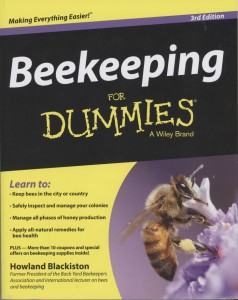
I have to admire Howland for his long time association with the Wiley folks. They do a dynamite job of promoting their products, they are absolutely everywhere, and they are using a few more photos than before, and there is that color section in the middle. But it does keep the cost down.
This edition, like the second has matured a bit which is good. For an author to get a second, and now a third chance to say what needs to be said is gratifying, and often self-correcting, a fact I am well aware of.
It comes in six parts with the18 chapters covering the introduce-you-to-beekeeping material, basic biology, overcoming apprehensions, which hive, what equipment, getting bees, examining a hive, seasonal activity, potential problems, CCD, pests and diseases and remedies, raising queens, a new section on honey, written by Marina Marchese (my coauthor for the Honey Connoisseur), harvesting honey, and finishing with his Parts Of Tens – 10 Fun Things To Do With Bees, including making splits, making hive stands, flowers for bees, mead, propolis, and beeswax. There’s a very helpful appendix on Resources in the industry, and for a bonus, there are coupons in the back that will get you all manner of bee things from business all over the place.
Wiley doesn’t re-do books that don’t sell, and this one does. It’s basic, mostly up to date, an easy read, enough photos to help and covers a lot of topics, some of which you will not see in most beginner books. It should be on your shelf if this is your first or second year.
Kim Flottum
August-Regional Honey Price Report
What’s Important?
August is when we poll our reporters to find out what it is, what they use, how they try to sell their honey. Now we’ve had many of these reporters helping us out every month for years. Some for many years, so they must have this figured out, at least to their own satisfaction. The one thing we did a tiny bit different this year was add a couple of new products, and look at some trends in different regions. We see the importance of this now and in future we’re going to focus more on how regions are the same, and different.
For now, price remains flat as a selling feature. How much isn’t as important as it used to be, and it still isn’t important as having your contact info on the label, even if it is the law in most places. But what that label looks like is much less important this year. We don’t know if that’s good or bad, but its’ certainly a bump in the down direction. Having local honey on the label is off this year which was a surprise, but one reporter told me that having local is getting tougher with Ireplacement bees every year, so honey is not as local as it used to be. Varietal honey is moving uptown for a change. We’d like to think that the GOOD FOOD AWARDS contest on honey flavors has something to do with that, along with a certain good book we know of, and the Davis Honey Tasting School that’s taking off.
New this is was our questions on how important is the gallon container (some), that RAW be on the label (more important this year than ANY other attribute), the color of the honey (some). Take a look, then take the best of this a turn it into money in your marketing plans.
Inner Cover
 It’s Father’s Day, 2015.
It’s Father’s Day, 2015.
It’s about 10 AM or so and I’m at the computer catching up on some correspondence from the previous week. The phone rings. 10 AM, Sunday. This cannot be good.
It isn’t. The call is from the County Sheriff’s office. Honey bees have invaded a truck stop on the edge of town. The employee there panicked and called them.
The call was simple enough: There’s a swarm of bees outside and what can you do because customers are getting stung lots of them and I’m afraid to even go outside and see what’s going on and people are leaving and there’s nobody here. HELP! HELP!
Well, Sheriff Deputies don’t do bee calls. What they do is make beekeeper calls and tag, Kim, you’re it this morning. They made a good handoff on that call, problem solved, what’s next?
What’s next is a problem, sort of. I don’t have transportation. We’re a one car household and the other half of the household has the car at church and won’t be back until after lunch. Sunday mornings are like that here and it’s good for both of us, I think.
So right off I called the truck stop and talked to the original caller. She’s excited. Nervous. Scared. Her manager isn’t answering the phone and what do I do next she asks. So I tell her it’s going to be OK, help is on the way, but I need to ask a few questions first – where, how big, how high – and there didn’t happen to be a truck recently with a big net over it getting gas by any chance? Well, it turns out that between the time she called the Sheriff and when I called, several customers had told her that was exactly what had happened and that’s where the bees were hanging out. Gas up and outta here was the plan, before we leave too many bees. So – how many is too many?
Anyway. OK, got the picture. So, call the President of the Medina County Beekeepers who is on the swarm call list too. She’s back from church now and takes the call. The President I called is Peggy Garnes who also works with us on the magazine. I tell her the story, she knows the truck stop real well because exactly the same thing happened last year on almost the exact same day. But right off she calls one of our members who lives nearby to see if he can help. He can. And does.
He takes a nuc with drawn comb, gets a queen from Peggy, who has a queen because she raises them to sell, and leaves it close to where the bees are. It’s not long before they find it, and mostly, problem solved. It ended up being a good size chunk of real ornery bees and he goes back after dark, picks up the nuc and takes it over to Peggy’s house. But let me tell you about the meanest bees on the planet when he went to move them from the truck to where they were to go. He’d stuffed a screen in the front door for the ride home, but bumpy road moved it a tiny, tiny bit. They started bombing both of them as soon as he stopped. By the time she gets them on the stand she’s covered in piss mean bees. Next morning she and her husband can’t leave the house. Mean, mean bees those bees. I’m sure they were carefully inspected in Florida. Inspected from inside the truck they were.
But you just know the story isn’t over.
I said it happened last year, at almost the exact time. Here’s why.
Out of state southern commercial beekeepers come to Medina and surrounding counties because there’s a pretty good Summer flow, not hardly any pesticides, and absolutely no government interference. Some make splits down south and sell them up here (inspected I’m sure, by the good folks who inspected those truck stop bees), or shake packages down there to sell to Ohio beekeepers (beware, Ohio beekeepers). They get a piece of paper in Florida that says there are no mites, small hive beetles or African bees in those hives and Ohio has to assume they are right because that’s the law. Any bets? I don’t care how good the Florida folks are – I got good money that says all three of those beasties are on every load and in every hive – maybe not many – but whether one or a million, nobody anywhere is counting.
But that’s not the worst of it, and here’s where our Ohio Department of Agriculture shows its true colors when it comes to supporting beekeeping and our Apiary program. Not.
Those out of state beekeepers can put their bees anywhere they can find a place to put their bees. Anywhere. But, once they hit the ground, where they hit is an apiary and they are supposed to register those bees with ODA, just like every beekeeper in Ohio has to, and registered bees are liable for inspection. But they all know that nobody, ever is going to bother to check up on them because nobody, hardly ever knows where they are. Unless they cause a problem.
Now, in Ohio, we have maybe as many as a dozen small operations raising queens. They’re trying to do a good job, and they want to produce queens that do well in Ohio. Some are supported by the Ohio State Beekeepers Association (see the letter in the Mailbox, by the way), others by local charitable groups, some are self-supporting, raising queens, selling nucs and making honey. So some rogue beekeeper from out of state sits his bees down just over the hill from one of these operations and doesn’t have to tell anybody, anywhere that he’s there. So our local queen producer suddenly has a pile of small hive beetles, Varroa out the ying yang, and starts sharing queens that have at least some AHB blood in them. But here’s the kicker – to sell queens in Ohio you have to be inspected – you got pests you don’t sell queens. And guess what – an Ohio business goes out of business because the state of Ohio doesn’t care a whit about beekeeping, honey bees or our local beekeepers. They cut the staff a few years back and to heck with them anymore. The migratory guy comes in, takes our honey, leaves his trash and we’re left to clean up his mess.
This has been going on for a bit, but it is escalating. Bees at truck stops, bees messing up our genetic lines, bees terrorizing our citizens. This has got to stop.
The Ohio State Beekeepers should be marching at the Department of Ag with signs and baseball bats declaring that at the very least, at the very least these criminals MUST declare their locations. That we have to move to stay clear of out of state trash is bad enough, but at least we’d know what’s over the hill. It’s no different than the beekeeper having to cover his hives on his land when the next door farmer sprays. Both of these insults are a hive tool in the eye, and the Ohio Department of Ag supports both and could care less. C O U L D C A R E L E S S.
I know this occurs in other states. I know other Agriculture departments feel the same, and local beekeepers get screwed. And by the way, how is your state dealing with this? Are you, too at the mercy of migratory genes? I read about it a lot on list serves and blogs. One beekeeper is stealing from another because he can. And local queen rearing operations everywhere are just as screwed as we are. This all may be legal, but the ethics stink. How much money is being spent on breeding programs in other states just to have them sabotaged by some greedy out of state thief I wonder? If you got into bees because you want to help the bees, I can’t think of anything better that you could do than to stop this practice, in Ohio, and in your state.
Just so you know, this is going to as many people in the Ohio Department of Ag that I can find, and to the Editors of The Medina Gazette and Post, The Record-Courier in Portage County, the Columbus Dispatch, the Toledo Blade and the Cincinnati Inquirer – for starters. Editors, and beekeepers have to stick together you know.
And we beekeepers do have to stick together because If we let this continue, there won’t be a local queen raised anywhere in the universe. And every hive will have small hive beetles, Varroa out the ying yang, and African bees can quit their migratory behavior. Beekeepers are doing it for them.
•
So, how do you . . . ?
Good friend and popular contributor for over 30 years Jim Tew recently had a book published by a publisher in the UK that had to do with 100 beekeeping questions. He’d pose a question and then offer a succinct answer, solving the problem he had originally asked. Not a lot unlike Phil’s column, or the one Gerry Hayes does in . . . that other magazine. It’s a good book, and if you haven’t yet, get a copy and take a look. He asks questions you never thought of, and then gives answers you’ll find useful.
Well, this got me to thinking recently. Some of bee work can be mind-numbingly dull, and a couple weeks ago I was removing the wax off of plastic foundation frames and got to thinking. It’s a pain in the butt, and I know there just has to be a better way than I do it, and even my way isn’t too bad. I throw all the frames in my rain barrel and let them soak for – as long as it takes for me to get back to the task and quit procrastinating. Usually a few days to a week or so.
When I pull them out, the drawn comb tends to be softer, and lets go of the foundation easier than if you just try and scrape it with a hive tool right out of the box. But it’s not perfect, and you will end up with busted knuckles and on occasion the hive tool gets a bite out of you and some frames are dead stubborn.
Now, for the past few years I’ve been a fairly strong advocate of not using commercially available beeswax foundation. Our tests here have shown thousands of ppb of miticides, sometimes tons of ag chemicals – we have fouled our nest, for sure. So, I start with plastic, let the bees build it out and after two or three years remove it and start over. I tried wax melters, and hot water, but they distort the plastic, so it’s soak and scrape for me.
So how do YOU remove old comb from plastic foundation? Send me a short description of what works for you and we are going to start this as a regular feature. And of course I’m quite certain you have problems that need solving differently than the way you are doing them, so send them in too. I’d like to have four or five good answers and four or five good question for every issue. What do you think? Send me your solution to removing wax, and send me a problem or five that you have that we can find answers for. Above, I said beekeepers have to stick together. This is one of the best ways I know how. Send questions and answers to me, Jerry@BeeCulture.com, with Q&A in the subject line so they don’t get mixed in with the 400 or so emails I get every day.
•
I’ve finished this on the evening of the 4th of July. There’s an old axiom about goldenrod – if it’s wet the first week of July, you’ll have a bumper crop of goldenrod the first week of September. We’ve had inches and inches and inches – probably feet of rain here in June. The ground is wet. I am anticipating a goldenrod harvest to die for. And now that I have frames to store it in, I’m all set.
Remember, keep your smoker lit, your hive tool handy and your veil tight. You’ll do better, and live longer.

It’s Summer Time
West Coast, Ducks and Travel
We had a great trip to the West Coast. First to Albany, Oregon for the Mother Earth News Fair. As usual it was a great time. This was the first time at this location and from my perspective it worked well. The numbers they are showing for attendance are 10,000 – amazing for the first time.
The Fair was similar to the other MEN’s fairs that we have attended, but there is always a local flair. There are three more Fairs this year – West Bend, WI; 7 Springs, PA and Kansas City. If you get a chance to visit one close to you, take the opportunity. You can’t imagine all of the things that are on display and for sale. There are over 200 workshops and that many vendors. We saw some pretty odd and amazing things – wicker caskets for sale.
The weather was a little drastic for us – it was 91° the first day. Kim’s daughter Jessica picked us up at the Eugene airport and it was about a 90 minute drive to Albany. It is so dry and brown out there, but we saw acres of wild blackberries growing along the side of every road. I’m not sure why we didn’t see beehives along side those same roads. We did see beehives in fields of meadowfoam which was also in full bloom.
It was a great time. The best part was getting to spend a few days with Jessica. She lives in southern Oregon and we don’t get to see her often enough. After the weekend she drove us to the Portland airport where we took a plane to San Francisco.
It was 100° when we arrived at my sister’s house just across the bay from San Francisco. We spent a few days with my sister and my younger son, Matt who lives with her. It was hot, brown and dry there also. The water situation is bad all over the west coast. It has been about four years since there has been any significant rainfall.

After San Francisco we landed in San Diego to visit my older brother who lives in Oceanside – which is pretty close to heaven on earth. It’s almost always 72° and sunny. I had to go the ocean. I love the ocean. Kim and I took several walks around my brother’s neighborhood just to be outside. Water is a big issue there also, but in spite of that there were flowers and plants blooming in abundance. It was great.
Back home while we were gone it was a rough week for our poultry. We had a young couple house-sitting for us. Four ducks and one of the young chickens went missing one day. No sign of them. Brandyn looked and looked and felt terrible that it happened on his watch. Our neighbor has a pond and in that pond is a snapping turtle. I’m hoping that the ducks took flight and didn’t head for the pond. So we’re at two ducks, 10 young chickens and eight of the old girls – we lost another one of the old ones after we got home.
Ducks and chickens are very vulnerable. Everything likes to eat chicken. I still think we’re doing pretty good. I’ve talked to some folks who’ve lost their whole flock to predators – hawks, fox, raccoons.
The ducks are pretty funny. I feel bad that we are down to two. They seem happy enough, and very entertaining. They are now quacking like real grown up ducks and make a lot of noise when exiting the coop in the morning. The ducks and the chickens now co-habitate quite nicely. We’ve had a little bit of bullying going on, but not too bad. The ducks are the last ones in at night. All of the chickens are in and ready for bed by about 8:30, the ducks stay out til around 9. They will come in when I whistle and call for them.
The ducks are still very skittish about being touched. If we can catch them inside the coop they settle down pretty quickly. Not sure yet if we have males or females – no eggs yet.
More travel is ahead for us. We’re off to England and Northern Ireland in just about a week. The trip will be mostly vacation, but Kim is giving one bee talk while we’re there. We will be visiting southern England, an area we haven’t been to before. After landing in London, we will take a four hour train ride to our destination. I’m looking forward to the train ride. England has a very good railway system. I’m anxious to sit back and look at the countryside. After some time in England we will travel over to Belfast to visit good friends there. It should be a great trip.
On a bit of a sad note we’re losing our good neighbor, Luca. Luca is 10 now. He moved in next door when he was five. We’ve gotten to know him pretty well. I had hoped we would get to watch him grow up, but not to be. The adults that rule his life have decided he’s moving back to Michigan. He touched our lives for a short time and hopefully we touched his. Neighbors come and go, sometimes becoming friends, sometimes just neighbors. Kim had the same neighbors – great neighbors – for about 25 years before Luca moved in. Let’s hope our next neighbors will be as sweet as he is.
I hope you are having a wonderful Summer, that your bees and gardens are doing well and that you are enjoying life. We’ve already had our first tomatoes and squash from our garden. Kim always says you should have your first tomatoes on the Fourth of July and we were there this year. Nothing better than that first tomato!







